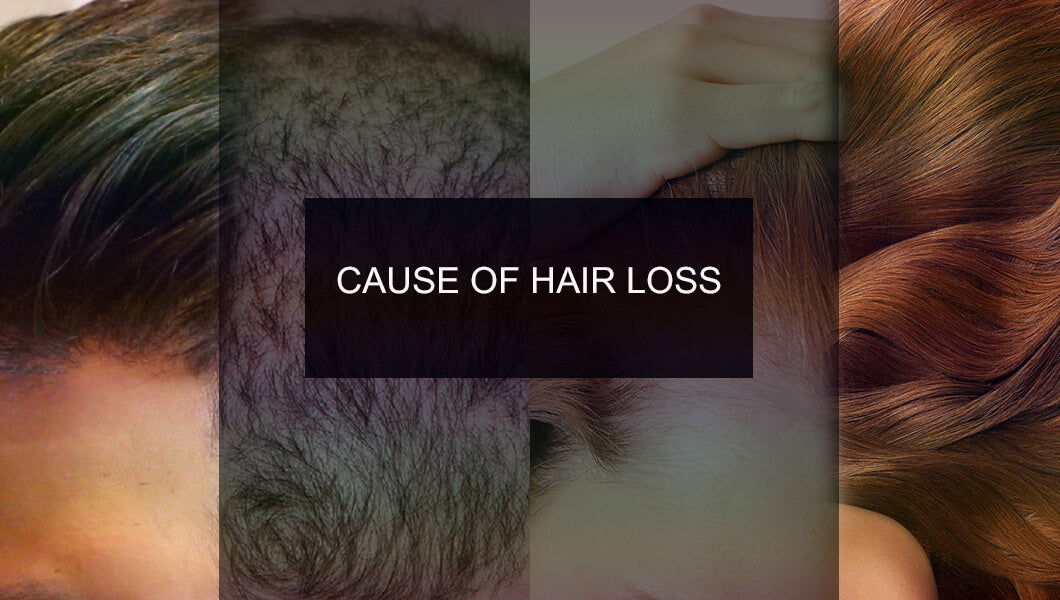As the previous section shows, there are numerous types of hair loss; this reflects the fact that there are also a wide variety of possible causes.
Tackling your situation can be made easier by knowing exactly what is engendering it.
At its most basic level, hair loss occurs when hair loss occurs when the cycle of hair growth and shedding is interrupted or when a hair follicle is destroyed and replaced with scar tissue. At a more detailed level, the top reasons fall into one or more of the following six categories: family history, hormonal changes, medical conditions, medications, dieting/nutrition, and hair care. These categories are discussed in detail over the next few pages.
1. Family History – The most common reason for hair loss is genetic in nature – specifically, the presence of a hereditary condition called male-pattern baldness or female patternbaldness (scientifically known as androgenetic alopecia). It typically happens gradually and with signs that are predictable – for men, bald spots and a receding hairline; for women, thinning hair. Genetic factors also impact the age at which people start to lose their hair, the speed at which this loss occurs, and the degree of baldness. Hair loss is frequently associated with the overall aging process, and with good reason; many people begin noticing mild thinning of their hair beginning in their 30s and 40s.

2. Hormonal Changes – Changes in hormone levels due to normal life events may lead to temporary hair loss. Examples includethe following:
-
- Pregnancy/giving birth: Women may experience hair loss during their pregnancies or after giving birth; this may result from decreasing estrogen levels. This is a temporarysituation, with hair usually growing back after a few
- Menopause: Hair loss often happens during a menopause phase. As with childbirth, this loss is not permanent;however, for women age 40 and older, the hair that grows back will probably not exhibit the same amount of fullness that it did prior.
- Stress: Going through a traumatic event (e.g., a divorce or a family death) can cause hormonal fluctuations that can lead to hair loss.
3. Medical Conditions – There are over 30 diseases that can leadto hair loss. Some of these are specifically related to hair follicles, such as the following:
-
- Alopecia areata: This condition is believed by scientists tobe an autoimmune disease (a situation in which the human body attacks itself). This specific example involves the body destroys its own hair; it results in round, smooth bald patches on the scalp and other body parts. Individuals with this condition are typically otherwise in good health, with their hair growing back eventually (often with the aid of a dermatologist).
- Cicatricial (scarring) alopecia: This condition is rare and develops in individuals who are generally healthy. Itattacks one’s hair follicles, resulting in inflammation and the formation of scar tissue that prevents hair regrowth. Treatment halts the inflammation.
- Central centrifugal cicatricial (scarring) alopecia: This variant of alopecia most commonly occurs among women of African descent. It starts at the center of the scalp, then radiates outward; the scalp becomes shiny and smooth. Hair loss may be slow or fast; rapid loss may lead to a tinglingpain or itching. Treatment aims to regrow the hair if scarring has not made that impossible.
- Scalp infections: Certain infections like ringworm(common in children) may infiltrate the hair and scalp, causing scaly patches and the loss of hair. Treatment of the infections generally results in hair regrowth.
 Other medical conditions ranging from the physical to the psychological may be causes. For example, skin conditions such as lichen planus, sarcoidosis, and certain types of lupus, which may cause scarring alopecia. Hormone levels are affected by the thyroid gland, so thyroid issues may result in hair loss. Trichotillomania is a mental disorder that causes people to pull out their own hair. And generally, conditions such as a strong fever, serious infection, and possibly even the flu can cause hair loss (a category known as telogen effluvium).
Other medical conditions ranging from the physical to the psychological may be causes. For example, skin conditions such as lichen planus, sarcoidosis, and certain types of lupus, which may cause scarring alopecia. Hormone levels are affected by the thyroid gland, so thyroid issues may result in hair loss. Trichotillomania is a mental disorder that causes people to pull out their own hair. And generally, conditions such as a strong fever, serious infection, and possibly even the flu can cause hair loss (a category known as telogen effluvium).
4. Medications – A variety of medications/supplements maycause hair loss as a side effect; they include:
-
- Blood thinners (often used for heart or blood vesseldisease)
- Pills that treat depression, arthritis, gout, high bloodpressure, and heart problems
- Birth control pills – hair loss may also occur oncewoman ceases taking them
- Anabolic steroids (used to buildmuscle)
- Cancer treatments such as chemotherapy andradiation therapy
5. Dieting/Nutrition – Doing a diet or overconsuming/underconsuming various nutrients can lead tohair loss, as the following examples show:
-
- Dieting: There are many documented cases in whichpeople lose hair after losing weight, usually more than 15 pounds. The hair loss tends to occur three to six months after weight loss; fortunately, it is only temporary.
- Vitamin A: Someone may obtain an overabundance of vitamin A through supplements or medicines. This can leadto hair loss, which stops once intake is cut down.
- Protein: When protein intake is too low, the body compensates by rationing out the available amount.One strategy it pursues is shutting down hair growth, which becomes apparent after two to three months. Increasing consumption will reverse the process,
-
Iron: Similarly, taking in too little iron can cause hair loss. Good sources of iron include oysters, clams, and organmeats; for vegetarians, they include soybeans, lentils, white beans, pumpkin seeds, and iron-fortified
cereals.
6. Hair care – The way you treat your hair can have consequencesin terms of hair loss:
-
- Chemicals: Using permanents or bleach too often cancause hair breakage; so can too-frequent usage of gels, dyes, relaxers, and hair sprays. It is recommended that people do not use these chemicals too
- Devices: Constant usage of blow dryers can damage the hair. A dryer has a high level of heat which can boil the water in the hair shaft, making the hair brittle and more susceptible to breakage. Dermatologists suggest that people air-dry their hair and style it afterwards. They also recommend reducing theuse of flat irons and curling irons.
- Accessories: Used to hold hair tightly, clips, hairpins,and rubber bands can also break it. Dermatologists have the following recommendations:
º Hairpins: Use those with a smooth, ball-tipped surface.
º Hair clips: Use those with a spongy rubber pad at the point at which they touch the hair.
º Rubber bands: Use scrunchies made of fabric as an alternative. Fit them loosely and wear them in varying parts of the scalp.
- Hairstyles: Styles that tug on the hair, such ascornrows, braids, and ponytails can result in a variant of hair loss called traction alopecia. Do not wear them too often.
-
Hair Maintenance: Improper cleaning andgrooming practices may cause hair breakage. These include the following:
- Too frequent combing, brushing (100 or more strokesa day), or shampooing
- Rubbing wet hair with a towel toohard
- Combing or brushing wet hair (especially for thosewho are Caucasian of Asian)

Is your hair thinning?
Do you need a solution to regrow your hair without taking medications?
We have the perfect therapy for you--ReHair® Laser Cap. Its a low- level laser light therapy that stimulates the hair follicle to regrow.

